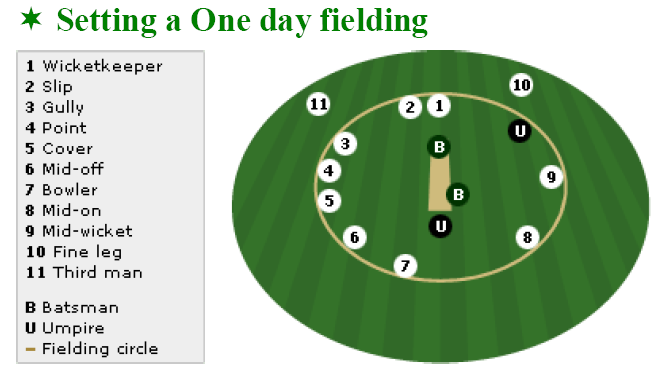One-day
cricket is all about scoring quickly - it's the fielding side's job to keep the
runs down and pick up wickets.
Unlike
Test cricket, the fielders are spread out to save the runs.
In
July 2005, the International Cricket Council (ICC) announced changes to the way
one-day cricket is played.
Before
that time, for the first 15 overs, nine fielders, including the bowler and the
wicket-keeper, had to be inside a 30-yard (27.5m) circle when the ball was
bowled.
The
circle was marked out by markers five yards (4.5m) apart, so the fielders - and
umpires - knew where to stand.
 However
under the new rules introduced in 2005 called Powerplays, the fielding
restrictions are replaced by three blocks totalling 20 overs.
However
under the new rules introduced in 2005 called Powerplays, the fielding
restrictions are replaced by three blocks totalling 20 overs.
Powerplays are signalled
by the umpire
|
During
the first 10 overs, now known as Powerplay 1, only two fielders
may be outside the fielding circle and at least two must be in catching positions.
Powerplay
2 and Powerplay 3 are five-over spells in which only three fielders may be
outside the fielding circle, but
there are no requirements about close
catchers. They must be taken within the 50-over innings.
The
fielding side decides when to take one of these powerplays, and in a rule
change introduced in October 2008, the batting side decides when the other
powerplay is taken.
A
powerplay can only be invoked before the start of an over, and the umpire
informed. The umpire will signal the start of the fielding side's choice of
powerplay by waving his arm in a circular motion - and indicate a powerplay
chosen by the batting side by waving his arms in a circle and then clapping his
hands above his head.
Usually
the fielding team will start with a third man and a fine leg to give the bowler
protection on the off and leg side.
With
a brand new ball the bowlers should get movement, so you'll usually see a
couple of slips and a gully to snap up those edges.
The
team's best - and quickest - fielders will often be at point and the covers.
Batsmen
will be looking to drop the ball into gaps for quick singles, so it's up to
these two to close down the space quickly and force run-outs.
With
only two fielders outside of the inner circle, the batsman can smash the
bowlers past the fielders for those boundaries and sixes in front of the
wicket.

The
fielding captain only needs four players inside the circle, plus the bowler and
wicket-keeper, when the ball is bowled.
This
means they can spread the field to protect the boundaries and save those precious
runs.
But
it's not as easy as that.
The
fielding team is allowed a maximum of five fielders on the leg side, so if your
bowlers are spraying the ball all over the place, you're in trouble.
The
two opening bowlers will bowl roughly five to six overs each, leaving them a
few at the end when the pressure is on.
But
it's when the second and third string bowlers come on that the field really
starts to spread.
These
are usually batsmen who can bowl a bit but are prone to deliver a few gifts.
So
for safety, a captain will usually push mid-on, mid-off and mid-wicket right
back onto the boundary.
They
also have the option of a deep point or square leg, depending on how quickly
the batsmen are scoring.
The
off-side field will be spread too, with a deep cover sweeping the boundary for
drives and cuts.
And
both mid-on and mid-off will be pushed right back on the boundary too.
So
there's plenty of quick singles on offer for the batsmen to keep the scores
ticking over.
But
they're after the big runs, so the gaps between deep cover and long off - as
well as deep mid-wicket and long on - are the main targets.

No comments:
Post a Comment